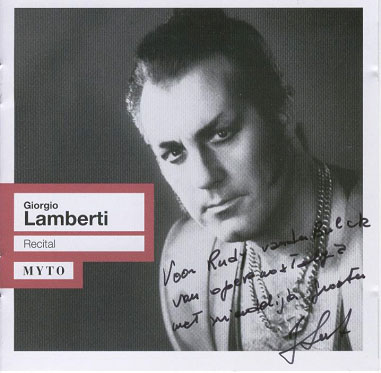
Giorgio (Casellato) Lamberti : Operatic Recital –Myto CD

By now Giorgio Casellato Lamberti must have been so tired of being called the brother of that other well known tenore leggiero Renzo Casellato (both were born in the same town) that he has dropped the Casellato and is just Giorgio Lamberti (as the sleeve notes make clear). Mr. Lamberti was a member of that last generation of the “once inexhaustible breed; the Italian tenor “. He came to prominence in the sixties together with other young hopefuls like Ruggero Bondino, Enzo Tei, Franco Tagliavini, Beniamino Prior and Luciano Pavarotti. Decca once promoted the Modenese tenor in its ads “as the only great tenor to come out of Italy for a whole generation” but anybody who listens to this CD will not agree with that publicity statement. Yes, Mr. Lamberti’s voice has not the many subtleties and the beauty in the middle register of Carlo Bergonzi; nor did he have the stentorian overwhelming sound of Corelli and Del Monaco but somewhere he was more representative of the breed than either one of those vocal gods. There is a red thread running through vocal history of talented Italians, trumpet voiced, who could cut through any orchestra and chorus. They didn’t have the amazing vocal beauty of Gigli or young Di Stefano but they did the heavy work in other houses than La Scala or the Met; they did the foreign tours where their sound was identified as typical Italian. I’m thinking of singers like Gillion, De Muro, Radaelli, Krismer, Merli, Chiaia, Tafuro. After the war there appeared Annaloro, Zambruno, Turrini, Lo Forese, Gismondo and Ottolini in that mould. Of them all Lamberti was definitely the best. He could fill big barns like La Scala and the Met. In a smaller house like De Munt Lamberti’s voice sounded even large as I remember from his Riccardo in Un Ballo. At the Verona Arena he had no problem filling the open space (He proved how nowadays snobbish managers are wrong when they prefer the Ur-Boris without the magnificent tenor-mezzo duo).
This CD gives us a fine example of the tenor’s art; his strengths and his weaknesses. The voice always sounds homogenous from bottom to brilliant top. It is slender but still strong with a lot of metal in it. It is bright and well focused. There aren’t a myriad amount of colours in it but it’s still personal and recognizable. The top can be cutting and is often glorious. Indeed one thinks of Hope-Wallace in The Gramophone once describing young Corelli as ‘a shameless top-note hunter”. So is Lamberti now and then, holding the high B in La donna è mobile for some ten seconds (as did Corelli). Well, why not for once ? Lamberti’s voice above the stave gets an extra gleam and ring and it is a prime example of squillo. There are some drawbacks too. He most of the time goes from forte to fortissimo and back. Piano is not in his dictionary; even mezza voce is rarely used though his voice doesn’t lose its beauty during the rare examples he provides. Mind you, he is not a sobber or a bawler. Indeed in the recitatives to Foscari, Macbeth and especially the start of the Africaine aria he proves he can phrase as well as the best of his precedessors. The arias sometimes lack a bit of imagination, sung straight through. He is better when he is angry (Tabarro), in rage (an excellent Boccanegra) or sad (Forza). He is less convincing when declaring his love (Aida or Trovatore and in Ah! Si ben mio he gives a single shake of the voice and no trill). That’s when the voice lacks warmth and charm. So do not expect a dreamlike Cielo e Mar. This is a man who is not going to wait a second longer than necessary to make love to Laura the moment she puts one foot on board (but, oh what a difference in pure vocal terms with a far less talented modern tenor like Marco Berti). Particularly interesting is his Capuleti-aria; well known too in the version of young Pavarotti. Lamberti’s voice is somewhat similar; maybe a little bit less rich. Still, the differences being slight they teach us a lesson. One singer marginally better than the other, is a household word due to an American publicity genius while the other is more or less forgotten in the wide world. Myto doesn’t give us recording dates, places or conductors (I wonder who that madman was in Di quella pira; still Lamberti succeeds in following the orchestra). As these are live recordings most of the time the voice sometimes seems to come from somewhat further but the sound is never below par. Typical is the consistence of the voice throughout the career. Maybe in his later years Lamberti’s top thickened somewhat and the voice itself became a bit more unyielding’s but it remained a tower of strength. It was not a happy idea of Myto to start the recital with one of his later performances as it gives a lesser impression than the rest of this long CD (31 arias –value for money). Though this has often been said before, it nevertheless remains a painful truth. If Mr. Lamberti was to sing now, he would reign supreme in Italy and in part of the rest of the world as well. In the tenor world of today only Calleja has more vocal qualities but the recent Italian crop (Berti, Filianote, Licitra, Meli) is a sorry bunch compared with Lamberti. Tenor buffs would do good to pick up this CD instead of the latest Villazon or even Florez.